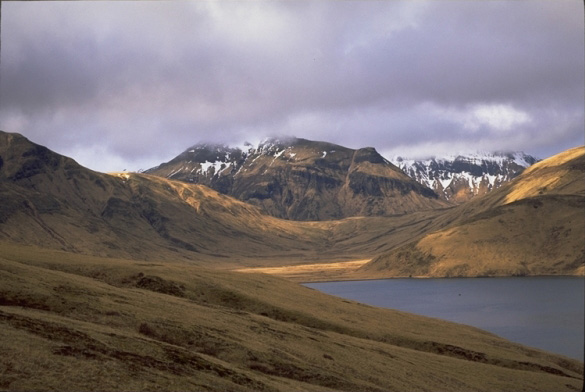
Head of Akutan Harbor, and location of hypocenters for the March, 1996 seismic swarm at Akutan. The low saddle separates the harbor from Hot Springs Bay.
Volcano(es): Akutan
Photographer: McGimsey, R. G.
URL: avo.alaska.edu/image/view/686
Akutan 1996/3
This seismic swarm is not considered to be an eruption of Akutan.
From Neal and McGimsey (1997): "On March 10 [1996], a seismic swarm severe enough to seriously alarm residents began beneath the island of Akutan in the eastern Aleutians. Nearly continuous ground shaking punctuated by occasional large shocks continued for 24 hours. After a lull, a second swarm occurred on March 13 and lasted for about 18 hours. During both episodes, felt earthquakes occurred at rates of up to one per minute; 30-40 earthquakes per hour were recorded on a seismic station at Dutton Volcano 270 km to the northeast. The largest of the individual shocks reached M5.3 and were felt in Dutch Harbor 50 km to the west. The second swarm caused minor damage to household items, interior walls and plumbing in the City of Akutan, 5 km east of the volcano. Although interpreted to be the result of a magmatic intrusion, the seismic swarm decayed over the next several weeks and no eruption ensued. AVO responded to the March seismic crisis by deploying a team to Akutan to install an emergency seismic network and begin real-time monitoring of continuing seismicity (Power and others, 1996). The team also discussed potential hazards with residents of Akutan and met with various groups of citizens and workers at the seafood processing plant to update them on the situation and potential hazards. Satellite images were routinely examined for anomalous thermal features or ash clouds. AVO staff in Anchorage and Fairbanks handled the information flow, interacted with a variety of private and public officials and the media, and established the receiving end of a new seismic data stream from Akutan. AVO went on 24-hour duty for a period of several weeks while Level of Concern Color Code Orange was instituted. Subsequently, during the summer, the Akutan seismic network was upgraded as part of the Central Aleutian seismic expansion [see fig. 8 in original text]. During this effort, AVO crews found a 20-km-long system of en echelon ground cracks that presumably formed during this event [see fig. 9 in original text]."
Use Restriction: Please cite the photographer and the Alaska Volcano Observatory/U.S. Geological Survey when using this image.
Full Resolution.